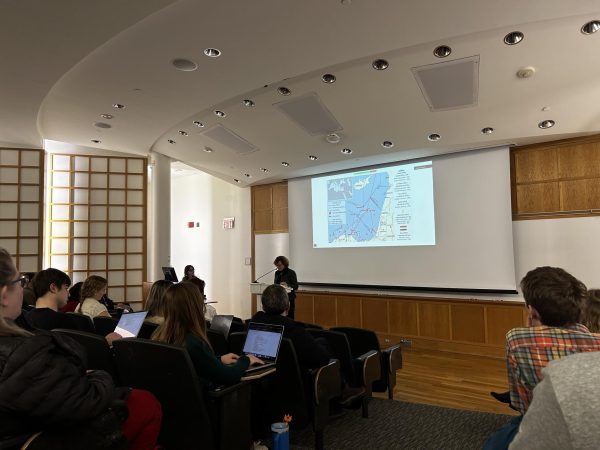Gobble Gobble: The History of Thanksgiving
“Pass the deer and eel please!” Are these the words you would expect to hear around your Thanksgiving dinner table? Probably not.When most people think of a traditional American Thanksgiving dinner, they often think of turkey, mashed potatoes, cranberry sauce, gravy and maybe even apple or pumpkin pie. The food that these early Americans shared at the original Thanksgiving dinner in 1621, however, was not what most people would expect. Before we discuss what was probably served at that table, we must first understand the origins of this feast. Although Thanksgiving did not become an official holiday until 1863, most Americans consider the Plymouth feast the first Thanksgiving. The true source of the bountiful harvest celebrated by Thanksgiving – the shift from communal farming to private farming, where the people in the Plymouth Colony got to keep the benefits of their own efforts instead of sharing in a communal effort – has not been widely publicized. Before traveling to America, for these Pilgrims, failure to conform to the Church of England was a capital crime. King James I (1603-1625) of England declared that all dissenters must conform to England’s worship and submit to England’s bishops, or “I will harry them out of the land, or else worse.” “Worse” clearly meant “death.” Still, to conform was impossible for a group of men and women. This group, which came to be called the Puritans, wanted to rid the Church of England of its historic Catholic connection and let the New Testament determine church order and worship.In 1607, the group fled to Holland, where its members could worship in a manner that did no violence to their consciences. After some years, however, they found that solution unsatisfactory. After all, their children, burdened with difficult labor, were growing up Dutch, not English. Being “knit together as a body in a most strict and sacred bond and covenant of the Lord,” the group of about 100 sailed from Plymouth, England, on September 6, 1620. Two months later, the Mayflower arrived near Cape Cod, where these settlers soon established their own Plymouth. The Pilgrims’ first winter in the New World was difficult. Many of us can recall learning that they had arrived too late to grow many crops, and without fresh food, half the colony died from disease. The following spring, the Native Americans taught them how to grow corn (maize), a new food for the colonists. They showed them other crops to grow in the unfamiliar soil and how to hunt and fish.Going back to the important matter of food served at the first Thanksgiving, bountiful crops of corn, barley, beans and pumpkins were harvested in the autumn of 1621. Fifty-two Pilgrims and 90 Native Americans came together in Plymouth, Massachusetts for meals celebrating the harvest. The colonists had much to be thankful for, so a feast was planned. The Native Americans brought deer to roast with the turkeys and other wild game offered by the colonists. The colonists had learned how to cook cranberries and different kinds of corn and squash dishes from the Indians. To this first Thanksgiving, the Indians had even brought popcorn. Pilgrims and Native Americans most likely ate turkey. Mashed potatoes, cranberry sauce and pumpkin or apple pie – sadly – were not on the menu. In 1621, potatoes were not part of the Pilgrims’ diet. According to Kathleen Curtin, a food historian at Plimoth Plantation, a living-history museum in Massachusetts, most Pilgrims had never heard of potatoes. Potatoes grew only in South America until the late 1600s. The Pilgrims and Native Americans may have eaten cranberries, but certainly not cranberry sauce. Sugar, an important ingredient in cranberry sauce, had probably not yet traveled to the New World. According to Curtin, “It would be 50 years before an Englishman mentioned boiling this New England berry with sugar.” But the Pilgrims must have eaten apple pie, right? Surprisingly, they did not. Apples do not naturally grow in North America. The fruit didn’t even actually come to the United States until decades later. So, what, then, did people eat at the first Thanksgiving? Back then, they probably had deer, clams, dried berries, corn, wild turkeys and fish, such as cod, eels and sea bass. And the meat certainly did not come in packages from the grocery store. “Animals were often cooked with heads and feet still attached. The ‘humbles’ [what we would call guts] were cooked and eaten as well,” Carolyn Travers, a researcher at Plimoth Plantation, explained. In following years, many of the original colonists celebrated the autumn harvest with a feast of thanks. After the United States became an independent country, Congress recommended one yearly day of thanksgiving for the whole nation to celebrate. George Washington suggested the date November 26 as Thanksgiving Day. Then, in 1863, at the end of a long and bloody civil war, Abraham Lincoln asked all Americans to set aside the last Thursday in November as a day of thanksgiving. This Thanksgiving, as you dig in, be thankful you’re eating turkey and pie – and not baked guts or eel!





